How Informed Design Can Make a Difference: Supporting Insect Pollinators in Cities
Abstract
:1. Introduction
- Which pollinators can be the focus of efforts to increase pollinator ecosystem services in cities?
- Which plants and what arrangements of plants are most attractive and supportive to pollinators in cities?
- What do urban pollinators need beyond floral resources?
- How can the surrounding landscape inform where to prioritize new habitat creation within cities?
2. Pollinators: Which Pollinators Can Be the Focus of Efforts to Increase Pollinator Ecosystem Services in Cities?
3. Plants: Which Plants and What Arrangements of Plants Are Most Attractive and Supportive to Pollinators in Cities?
3.1. Native vs. Non-Native Plants
3.2. Floral Features
3.3. Floral Arrangement in Time
3.4. Floral Arrangement within a Green Space
4. Nesting Habitat: What Do Urban Pollinators Need beyond Floral Resources?
5. Landscape-Level Planning and Connectivity—How Can the Surrounding Landscape Inform Where to Prioritize New Habitat Creation within Cities?
5.1. Matrix Quality
5.2. Size, Arrangement, and Connectivity of Green Space within the Urban Matrix
6. Management—What Urban Management Practices Would Support Pollinator Ecosystem Services?
7. Conclusions and Planning Recommendations
7.1. Summary of Planting Recommendations at the Local Scale
- Incorporate high densities of flowering plants, including flowering trees.
- Incorporate a high diversity of flowering species by varying the species and floral features in each bed across the landscape.
- Utilize species with flowering times that span the entire growing season, including beneficial spring bulbs and late-blooming fall flowers.
- In areas with high aesthetic and maintenance requirements, utilize non-native, ornamental, or “nativar” plants that provide pollinator resources but do not pose a risk of invasive spread.
- In areas with lower aesthetic and maintenance requirements, utilize as many native plants as possible.
- Seek out native plants that are well-adapted to the harsh conditions of urban environments. Some desirable characteristics include salt, heat, and drought tolerance and higher pH tolerance.
- Avoid the widespread use of wood mulch; instead, create a mix of bare ground and leaf litter cover to support bees with different nesting requirements.
- Where appropriate, use plants as “living mulch” to maximize plant resources and reduce weeding and watering requirements.
- Look for opportunities to “improve the matrix” between garden beds. Consider bee-friendly lawns, flowering trees, and functional planters that can provide additional support between garden beds.
7.2. Summary of Landscape-Scale Recommendations for Urban Planning
7.3. Conclusions
Author Contributions
Funding
Data Availability Statement
Conflicts of Interest
References
- Potts, S.G.; Biesmeijer, J.C.; Kremen, C.; Neumann, P.; Schweiger, O.; Kunin, W.E. Global Pollinator Declines: Trends, Impacts and Drivers. Trends Ecol. Evol. 2010, 25, 345–353. [Google Scholar] [CrossRef]
- Pleasants, J.M.; Oberhauser, K.S. Milkweed Loss in Agricultural Fields Because of Herbicide Use: Effect on the Monarch Butterfly Population. Insect Conserv. Divers. 2013, 6, 135–144. [Google Scholar] [CrossRef]
- Goulson, D.; Nicholls, E.; Botías, C.; Rotheray, E.L. Bee Declines Driven by Combined Stress from Parasites, Pesticides, and Lack of Flowers. Science 2015, 347, 1255957. [Google Scholar] [CrossRef]
- Nicolson, S.W.; Wright, G.A. Plant—Pollinator Interactions and Threats to Pollination. Funct. Ecol. 2017, 31, 22–25. [Google Scholar] [CrossRef] [Green Version]
- IPBES. The Assessment Report of the Intergovernmental Science-Policy Platform on Biodiversity and Ecosystem Services on Pollinators, Pollination and Food Production; Potts, S.G., Imperatriz-Fonseca, V.L., Ngo, H.T., Eds.; Secretariat of the Intergovernmental Science-Policy Platform on Biodiversity and Ecosystem Services: Bonn, Germany, 2016; 552p. [Google Scholar]
- Biesmeijer, J.C.; Roberts, S.P.M.; Reemer, M.; Ohlemüller, R.; Edwards, M.; Peeters, T.; Schaffers, A.P.; Potts, S.G.; Kleukers, R.; Thomas, C.D.; et al. Parallel Declines in Pollinators and Insect-Pollinated Plants in Britain and the Netherlands. Science 2006, 313, 351–354. [Google Scholar] [CrossRef] [PubMed]
- Burkle, L.A.; Marlin, J.C.; Knight, T.M. Plant-Pollinator Interactions over 120 Years: Loss of Species, Co-Occurrence, and Function. Science 2013, 339, 1611–1615. [Google Scholar] [CrossRef] [PubMed] [Green Version]
- Cameron, S.A.; Lozier, J.D.; Strange, J.P.; Koch, J.B.; Cordes, N.; Solter, L.F.; Griswold, T.L. Patterns of Widespread Decline in North American Bumble Bees. Proc. Natl. Acad. Sci. 2011, 108, 662–667. [Google Scholar] [CrossRef] [PubMed] [Green Version]
- Martins, A.C.; Gonçalves, R.B.; Melo, G.A.R. Changes in Wild Bee Fauna of a Grassland in Brazil Reveal Negative Effects Associated with Growing Urbanization during the Last 40 Years. Zoologia (Curitiba) 2013, 30, 157–176. [Google Scholar] [CrossRef]
- Balmford, A.; Bruner, A.; Cooper, P.; Costanza, R.; Farber, S.; Green, R.E.; Jenkins, M.; Jefferiss, P.; Jessamy, V.; Madden, J.; et al. Ecology: Economic Reasons for Conserving Wild Nature. Science 2002, 297, 950–953. [Google Scholar] [CrossRef] [Green Version]
- Leemans, R.; Groot, R.S. de Millennium Ecosystem Assessment: Ecosystems and Human Well-Being: A Framework for Assessment; Island Press: Washington, DC, USA, 2003; ISBN 978-1-55963-402-1. [Google Scholar]
- Ollerton, J.; Winfree, R.; Tarrant, S. How Many Flowering Plants Are Pollinated by Animals? Oikos 2011, 120, 321–326. [Google Scholar] [CrossRef]
- Klein, A.-M.; Vaissière, B.E.; Cane, J.H.; Steffan-Dewenter, I.; Cunningham, S.A.; Kremen, C.; Tscharntke, T. Importance of Pollinators in Changing Landscapes for World Crops. Proc. R. Soc. B Biol. Sci. 2007, 274, 303–313. [Google Scholar] [CrossRef] [Green Version]
- Gallai, N.; Salles, J.-M.; Settele, J.; Vaissière, B.E. Economic Valuation of the Vulnerability of World Agriculture Confronted with Pollinator Decline. Ecol. Econ. 2009, 68, 810–821. [Google Scholar] [CrossRef]
- Reilly, J.R.; Artz, D.R.; Biddinger, D.; Bobiwash, K.; Boyle, N.K.; Brittain, C.; Brokaw, J.; Campbell, J.W.; Daniels, J.; Elle, E.; et al. Crop Production in the USA Is Frequently Limited by a Lack of Pollinators. Proc. R. Soc. B Biol. Sci. 2020, 287, 20200922. [Google Scholar] [CrossRef] [PubMed]
- Fuller, R.A.; Irvine, K.N.; Devine-Wright, P.; Warren, P.H.; Gaston, K.J. Psychological Benefits of Greenspace Increase with Biodiversity. Biol. Lett. 2007, 3, 390–394. [Google Scholar] [CrossRef] [PubMed] [Green Version]
- Harrison, T.; Winfree, R. Urban Drivers of Plant-Pollinator Interactions. Funct. Ecol. 2015, 29, 879–888. [Google Scholar] [CrossRef]
- Ayers, A.C.; Rehan, S.M. Supporting Bees in Cities: How Bees Are Influenced by Local and Landscape Features. Insects 2021, 12, 128. [Google Scholar] [CrossRef]
- Prendergast, K.S.; Dixon, K.W.; Bateman, P.W. A Global Review of Determinants of Native Bee Assemblages in Urbanised Landscapes. Insect Conserv. Divers. 2022, 15, 385–405. [Google Scholar] [CrossRef]
- Ahrné, K.; Bengtsson, J.; Elmqvist, T. Bumble Bees (Bombus spp.) along a Gradient of Increasing Urbanization. PLoS ONE 2009, 4, e5574. [Google Scholar] [CrossRef] [Green Version]
- Geslin, B.; Gauzens, B.; Thébault, E.; Dajoz, I. Plant Pollinator Networks along a Gradient of Urbanisation. PLoS ONE 2013, 8, e63421. [Google Scholar] [CrossRef]
- Jones, E.L.; Leather, S.R. Invertebrates in Urban Areas: A Review. EJE 2013, 109, 463–478. [Google Scholar] [CrossRef] [Green Version]
- Baldock, K.C.; Goddard, M.A.; Hicks, D.M.; Kunin, W.E.; Mitschunas, N.; Osgathorpe, L.M.; Potts, S.G.; Robertson, K.M.; Scott, A.V.; Stone, G.N. Where Is the UK’s Pollinator Biodiversity? The Importance of Urban Areas for Flower-Visiting Insects. Proc. R. Soc. B Biol. Sci. 2015, 282, 20142849. [Google Scholar] [CrossRef] [Green Version]
- Hall, D.M.; Camilo, G.R.; Tonietto, R.K.; Ollerton, J.; Ahrné, K.; Arduser, M.; Ascher, J.S.; Baldock, K.C.R.; Fowler, R.; Frankie, G.; et al. The city as a refuge for insect pollinators. Conserv. Biol. 2017, 31, 24–29. [Google Scholar] [CrossRef] [Green Version]
- Wenzel, A.; Grass, I.; Belavadi, V.V.; Tscharntke, T. How Urbanization Is Driving Pollinator Diversity and Pollination—A Systematic Review. Biol. Conserv. 2020, 241, 108321. [Google Scholar] [CrossRef]
- Potter, A.; LeBuhn, G. Pollination Service to Urban Agriculture in San Francisco, CA. Urban Ecosyst. 2015, 18, 885–893. [Google Scholar] [CrossRef]
- Goulson, D.; Lepais, O.; O’connor, S.; Osborne, J.L.; Sanderson, R.A.; Cussans, J.; Goffe, L.; Darvill, B. Effects of Land Use at a Landscape Scale on Bumblebee Nest Density and Survival. J. Appl. Ecol. 2010, 47, 1207–1215. [Google Scholar] [CrossRef] [Green Version]
- Langellotto, G.A.; Melathopoulos, A.; Messer, I.; Anderson, A.; McClintock, N.; Costner, L. Garden Pollinators and the Potential for Ecosystem Service Flow to Urban and Peri-Urban Agriculture. Sustainability 2018, 10, 2047. [Google Scholar] [CrossRef] [Green Version]
- Silva, V.H.D.; Gomes, I.N.; Cardoso, J.C.F.; Bosenbecker, C.; Silva, J.L.S.; Cruz-Neto, O.; Oliveira, W.; Stewart, A.B.; Lopes, A.V.; Maruyama, P.K. Diverse Urban Pollinators and Where to Find Them. Biol. Conserv. 2023, 281, 110036. [Google Scholar] [CrossRef]
- Baldock, K.C. Opportunities and Threats for Pollinator Conservation in Global Towns and Cities. Curr. Opin. Insect Sci. 2020, 38, 63–71. [Google Scholar] [CrossRef] [PubMed]
- Xerces.org. Available online: https://xerces.org/publications/guidelines/pollinator-friendly-parks (accessed on 23 May 2023).
- Aronson, M.F.; Lepczyk, C.A.; Evans, K.L.; Goddard, M.A.; Lerman, S.B.; MacIvor, J.S.; Nilon, C.H.; Vargo, T. Biodiversity in the City: Key Challenges for Urban Green Space Management. Front. Ecol. Environ. 2017, 15, 189–196. [Google Scholar] [CrossRef] [Green Version]
- Llodrà-Llabrés, J.; Cariñanos, P. Enhancing Pollination Ecosystem Service in Urban Green Areas: An Opportunity for the Conservation of Pollinators. Urban For. Urban Green. 2022, 74, 127621. [Google Scholar] [CrossRef]
- Davis, A.Y.; Lonsdorf, E.V.; Shierk, C.R.; Matteson, K.C.; Taylor, J.R.; Lovell, S.T.; Minor, E.S. Enhancing Pollination Supply in an Urban Ecosystem through Landscape Modifications. Landsc. Urban Plan. 2017, 162, 157–166. [Google Scholar] [CrossRef] [Green Version]
- Bertuol-Garcia, D.; Morsello, C.; El-Hani, C.N.; Pardini, R. A Conceptual Framework for Understanding the Perspectives on the Causes of the Science–Practice Gap in Ecology and Conservation. Biol. Rev. 2018, 93, 1032–1055. [Google Scholar] [CrossRef]
- Enquist, C.A.; Jackson, S.T.; Garfin, G.M.; Davis, F.W.; Gerber, L.R.; Littell, J.A.; Tank, J.L.; Terando, A.J.; Wall, T.U.; Halpern, B.; et al. Foundations of Translational Ecology. Front. Ecol. Environ. 2017, 15, 541–550. [Google Scholar] [CrossRef] [Green Version]
- Toomey, A.H.; Knight, A.T.; Barlow, J. Navigating the Space between Research and Implementation in Conservation. Conserv. Lett. 2017, 10, 619–625. [Google Scholar] [CrossRef]
- Nascimento, V.T.; Agostini, K.; Souza, C.S.; Maruyama, P.K. Tropical Urban Areas Support Highly Diverse Plant-Pollinator Interactions: An Assessment from Brazil. Landsc. Urban. Plan. 2020, 198, 103801. [Google Scholar] [CrossRef]
- Maruyama, P.K.; Bonizário, C.; Marcon, A.P.; D’Angelo, G.; da Silva, M.M.; da Silva Neto, E.N.; Oliveira, P.E.; Sazima, I.; Sazima, M.; Vizentin-Bugoni, J.; et al. Plant-Hummingbird Interaction Networks in Urban Areas: Generalization and the Importance of Trees with Specialized Flowers as a Nectar Resource for Pollinator Conservation. Biol. Conserv. 2019, 230, 187–194. [Google Scholar] [CrossRef]
- Diniz, U.M.; Lima, S.A.; Machado, I.C.S. Short-Distance Pollen Dispersal by Bats in an Urban Setting: Monitoring the Movement of a Vertebrate Pollinator through Fluorescent Dyes. Urban Ecosyst. 2019, 22, 281–291. [Google Scholar] [CrossRef]
- Smith, T.J.; Saunders, M.E. Honey Bees: The Queens of Mass Media, despite Minority Rule among Insect Pollinators. Insect Conserv. Divers. 2016, 9, 384–390. [Google Scholar] [CrossRef]
- Adamson, N.; Roulston, T.; Fell, R.; Mullins, D. From April to August—Wild Bees Pollinating Crops through the Growing Season in Virginia, USA. Environ. Entomol. 2012, 41, 813–821. [Google Scholar] [CrossRef] [Green Version]
- Paini, D.R. Impact of the Introduced Honey Bee (Apis mellifera) (Hymenoptera: Apidae) on Native Bees: A Review. Austral. Ecol. 2004, 29, 399–407. [Google Scholar] [CrossRef]
- MacInnis, G.; Normandin, E.; Ziter, C.D. Decline in Wild Bee Species Richness Associated with Honey Bee (Apis mellifera L.) Abundance in an Urban Ecosystem. PeerJ 2023, 11, e14699. [Google Scholar] [CrossRef]
- Senapathi, D.; Biesmeijer, J.C.; Breeze, T.D.; Kleijn, D.; Potts, S.G.; Carvalheiro, L.G. Pollinator Conservation—The Difference between Managing for Pollination Services and Preserving Pollinator Diversity. Curr. Opin. Insect Sci. 2015, 12, 93–101. [Google Scholar] [CrossRef] [Green Version]
- Senapathi, D.; Goddard, M.A.; Kunin, W.E.; Baldock, K.C.R. Landscape Impacts on Pollinator Communities in Temperate Systems: Evidence and Knowledge Gaps. Funct. Ecol. 2017, 31, 26–37. [Google Scholar] [CrossRef] [Green Version]
- Holm, H. Pollinators of Native Plants; Pollination Press LLC: Minnetonka, MN, USA, 2014; ISBN 97809913563001. [Google Scholar]
- Geslin, B.; Le Féon, V.; Folschweiller, M.; Flacher, F.; Carmignac, D.; Motard, E.; Perret, S.; Dajoz, I. The Proportion of Impervious Surfaces at the Landscape Scale Structures Wild Bee Assemblages in a Densely Populated Region. Ecol. Evol. 2016, 6, 6599–6615. [Google Scholar] [CrossRef] [PubMed] [Green Version]
- Hinners, S.J.; Kearns, C.A.; Wessman, C.A. Roles of Scale, Matrix, and Native Habitat in Supporting a Diverse Suburban Pollinator Assemblage. Ecol. Appl. 2012, 22, 1923–1935. [Google Scholar] [CrossRef] [PubMed]
- Vaughan, M.; Black, S.H. Enhancing Nest Sites For Native Bee Crop Pollinators. Agroforestry note 34; USDA National Agroforestry Center: Lincoln, NE, USA, 2007. [Google Scholar]
- Bates, A.J.; Sadler, J.P.; Fairbrass, A.J.; Falk, S.J.; Hale, J.D.; Matthews, T.J. Changing Bee and Hoverfly Pollinator Assemblages along an Urban-Rural Gradient. PLoS ONE 2011, 6, e23459. [Google Scholar] [CrossRef]
- Daniels, B.; Jedamski, J.; Ottermanns, R.; Ross-Nickoll, M. A “Plan Bee” for Cities: Pollinator Diversity and Plant-Pollinator Interactions in Urban Green Spaces. PLoS ONE 2020, 15, e0235492. [Google Scholar] [CrossRef]
- Persson, A.S.; Ekroos, J.; Olsson, P.; Smith, H.G. Wild Bees and Hoverflies Respond Differently to Urbanisation, Human Population Density and Urban Form. Landsc. Urban Plan. 2020, 204, 103901. [Google Scholar] [CrossRef]
- Chong, K.Y.; Teo, S.; Kurukulasuriya, B.; Chung, Y.F.; Rajathurai, S.; Tan, H.T.W. Not All Green Is as Good: Different Effects of the Natural and Cultivated Components of Urban Vegetation on Bird and Butterfly Diversity. Biol. Conserv. 2014, 171, 299–309. [Google Scholar] [CrossRef]
- Dylewski, Ł.; Maćkowiak, Ł.; Banaszak-Cibicka, W. Are All Urban Green Spaces a Favourable Habitat for Pollinator Communities? Bees, Butterflies and Hoverflies in Different Urban Green Areas. Ecol. Entomol. 2019, 44, 678–689. [Google Scholar] [CrossRef]
- Pardee, G.L.; Philpott, S.M. Native Plants Are the Bee’s Knees: Local and Landscape Predictors of Bee Richness and Abundance in Backyard Gardens. Urban Ecosyst. 2014, 17, 641–659. [Google Scholar] [CrossRef] [Green Version]
- Salisbury, A.; Armitage, J.; Bostock, H.; Perry, J.; Tatchell, M.; Thompson, K. Editor’s Choice: Enhancing Gardens as Habitats for Flower-Visiting Aerial Insects (Pollinators): Should We Plant Native or Exotic Species? J. Appl. Ecol. 2015, 52, 1156–1164. [Google Scholar] [CrossRef]
- Wojcik, V.A.; McBride, J.R. Common Factors Influence Bee Foraging in Urban and Wildland Landscapes. Urban Ecosyst. 2012, 15, 581–598. [Google Scholar] [CrossRef]
- Tonietto, R.; Fant, J.; Ascher, J.; Ellis, K.; Larkin, D. A Comparison of Bee Communities of Chicago Green Roofs, Parks and Prairies. Landsc. Urban Plan. 2011, 103, 102–108. [Google Scholar] [CrossRef]
- Tallamy, D.W.; Narango, D.L.; Mitchell, A.B. Do Non-Native Plants Contribute to Insect Declines? Ecol. Entomol. 2020, 46, 729–742. [Google Scholar] [CrossRef]
- Erickson, E.; Adam, S.; Russo, L.; Wojcik, V.; Patch, H.M.; Grozinger, C.M. More Than Meets the Eye? The Role of Annual Ornamental Flowers in Supporting Pollinators. Environ. Entomol. 2020, 49, 178–188. [Google Scholar] [CrossRef]
- Fukase, J. Increased Pollinator Activity in Urban Gardens with More Native Flora. Appl. Ecol. Env. Res. 2016, 14, 297–310. [Google Scholar] [CrossRef]
- Rollings, R.; Goulson, D. Quantifying the Attractiveness of Garden Flowers for Pollinators. J. Insect. Conserv. 2019, 23, 803–817. [Google Scholar] [CrossRef] [Green Version]
- Frankie, G.W.; Thorp, R.W.; Schindler, M.; Hernandez, J.; Ertter, B.; Rizzardi, M. Ecological Patterns of Bees and Their Host Ornamental Flowers in Two Northern California Cities. J. Kans. Entomol. Soc. 2005, 78, 227–246. [Google Scholar] [CrossRef]
- Wojcik, V.A.; Frankie, G.W.; Thorp, R.W.; Hernandez, J.L. Seasonality in Bees and Their Floral Resource Plants at a Constructed Urban Bee Habitat in Berkeley, California. J. Kans. Entomol. 2008, 81, 15–28. [Google Scholar] [CrossRef]
- Praz, C.J.; Müller, A.; Dorn, S. Specialized Bees Fail to Develop on Non-Host Pollen: Do Plants Chemically Protect Their Pollen. Ecology 2008, 89, 795–804. [Google Scholar] [CrossRef] [Green Version]
- Winfree, R.; Fox, W.J.; Williams, N.M.; Reilly, J.R.; Cariveau, D.P. Abundance of Common Species, Not Species Richness, Drives Delivery of a Real-World Ecosystem Service. Ecol. Lett. 2015, 18, 626–635. [Google Scholar] [CrossRef] [PubMed]
- Morales, C.L.; Traveset, A. A Meta-Analysis of Impacts of Alien vs. Native Plants on Pollinator Visitation and Reproductive Success of Co-Flowering Native Plants. Ecol. Lett. 2009, 12, 716–728. [Google Scholar] [CrossRef] [Green Version]
- von der Lippe, M.; Kowarik, I. Do Cities Export Biodiversity? Traffic as Dispersal Vector across Urban–Rural Gradients. Divers. Distrib. 2008, 14, 18–25. [Google Scholar] [CrossRef]
- McLean, P.; Gallien, L.; Wilson, J.R.U.; Gaertner, M.; Richardson, D.M. Small Urban Centres as Launching Sites for Plant Invasions in Natural Areas: Insights from South Africa. Biol. Invasions 2017, 19, 3541–3555. [Google Scholar] [CrossRef]
- Garbuzov, M.; Ratnieks, F.L.W. The Strengths and Weaknesses of Lists of Garden Plants to Help Pollinators: The Strengths and Weaknesses of Lists of Garden Plants to Help Pollinators. BioScience 2014, 64, 1019–1026. [Google Scholar] [CrossRef] [Green Version]
- Nassauer, J.I. Messy Ecosystems, Orderly Frames. Landsc. J. 1995, 14, 161–170. [Google Scholar] [CrossRef] [Green Version]
- Somme, L.; Moquet, L.; Quinet, M.; Vanderplanck, M.; Michez, D.; Lognay, G.; Jacquemart, A.-L. Food in a Row: Urban Trees Offer Valuable Floral Resources to Pollinating Insects. Urban Ecosyst. 2016, 19, 1149–1161. [Google Scholar] [CrossRef]
- Lowenstein, D.M.; Matteson, K.C.; Minor, E.S. Evaluating the Dependence of Urban Pollinators on Ornamental, Non-Native, and ‘Weedy’ Floral Resources. Urban Ecosyst. 2019, 22, 293–302. [Google Scholar] [CrossRef]
- Staab, M.; Pereira-Peixoto, M.H.; Klein, A.-M. Exotic Garden Plants Partly Substitute for Native Plants as Resources for Pollinators When Native Plants Become Seasonally Scarce. Oecologia 2020, 194, 465–480. [Google Scholar] [CrossRef]
- Davis, M.A.; Chew, M.K.; Hobbs, R.J.; Lugo, A.E.; Ewel, J.J.; Vermeij, G.J.; Brown, J.H.; Rosenzweig, M.L.; Gardener, M.R.; Carroll, S.P.; et al. Don’t Judge Species on Their Origins. Nature 2011, 474, 153–154. [Google Scholar] [CrossRef] [PubMed]
- Coombs, G. Monarda Research Report. Available online: https://issuu.com/mtcuba/docs/monarda-report-final/1 (accessed on 17 February 2021).
- Baisden, E.C.; Tallamy, D.W.; Narango, D.L.; Boyle, E. Do Cultivars of Native Plants Support Insect Herbivores? HortTechnology 2018, 28, 596–606. [Google Scholar] [CrossRef] [Green Version]
- Fenster, C.B.; Armbruster, W.S.; Wilson, P.; Dudash, M.R.; Thomson, J.D. Pollination Syndromes and Floral Specialization. Annu. Rev. Ecol. Evol. Syst. 2004, 35, 375–403. [Google Scholar] [CrossRef]
- Robbins, P.; Birkenholtz, T. Turfgrass Revolution: Measuring the Expansion of the American Lawn. Land Use Policy 2003, 20, 181–194. [Google Scholar] [CrossRef]
- Ignatieva, M.; Ahrné, K.; Wissman, J.; Eriksson, T.; Tidåker, P.; Hedblom, M.; Kätterer, T.; Marstorp, H.; Berg, P.; Eriksson, T. Lawn as a Cultural and Ecological Phenomenon: A Conceptual Framework for Transdisciplinary Research. Urban For. Urban Green. 2015, 14, 383–387. [Google Scholar] [CrossRef] [Green Version]
- Robbins, P. Lawn People: How Grasses, Weeds, and Chemicals Make Us Who We Are; Temple University Press: Philadelphia, PA, USA, 2012; ISBN 9781592135806. [Google Scholar]
- Jenkins, V. The Lawn: A History of an American Obsession; Smithsonian Institution: Washington, DC, USA, 1994; ISBN 9781560984061. [Google Scholar]
- Nassauer, J.I.; Wang, Z.; Dayrell, E. What Will the Neighbors Think? Cultural Norms and Ecological Design. Landsc. Urban Plan. 2009, 92, 282–292. [Google Scholar] [CrossRef]
- Sehrt, M.; Bossdorf, O.; Freitag, M.; Bucharova, A. Less Is More! Rapid Increase in Plant Species Richness after Reduced Mowing in Urban Grasslands. Basic Appl. Ecol. 2020, 42, 47–53. [Google Scholar] [CrossRef]
- Fetridge, E.D.; Ascher, J.S.; Langellotto, G.A. The Bee Fauna of Residential Gardens in a Suburb of New York City (Hymenoptera: Apoidea). Ann. Entomol. Soc. Am. 2008, 101, 1067–1077. [Google Scholar] [CrossRef]
- Lerman, S.B.; Contosta, A.R.; Milam, J.; Bang, C. To Mow or to Mow Less: Lawn Mowing Frequency Affects Bee Abundance and Diversity in Suburban Yards. Biol. Conserv. 2018, 221, 160–174. [Google Scholar] [CrossRef]
- Knight, T.M.; Ashman, T.-L.; Bennett, J.M.; Burns, J.H.; Passonneau, S.; Steets, J.A. Reflections on, and Visions for, the Changing Field of Pollination Ecology. Ecol. Lett. 2018, 1282–1295. [Google Scholar] [CrossRef] [Green Version]
- Smith, R.M.; Gaston, K.J.; Warren, P.H.; Thompson, K. Urban Domestic Gardens (VIII): Environmental Correlates of Invertebrate Abundance. Biodivers. Conserv. 2006, 15, 2515–2545. [Google Scholar] [CrossRef]
- Hülsmann, M.; von Wehrden, H.; Klein, A.-M.; Leonhardt, S.D. Plant Diversity and Composition Compensate for Negative Effects of Urbanization on Foraging Bumble Bees. Apidologie 2015, 46, 760–770. [Google Scholar] [CrossRef]
- Keasar, T. The Spatial Distribution of Nonrewarding Artificial Flowers Affects Pollinator Attraction. Anim. Behav. 2000, 60, 639–646. [Google Scholar] [CrossRef] [PubMed] [Green Version]
- Normandin, É.; Vereecken, N.J.; Buddle, C.M.; Fournier, V. Taxonomic and Functional Trait Diversity of Wild Bees in Different Urban Settings. PeerJ 2017, 5, e3051. [Google Scholar] [CrossRef] [Green Version]
- Plascencia, M.; Philpott, S.M. Floral Abundance, Richness, and Spatial Distribution Drive Urban Garden Bee Communities. Bull. Entomol. Res. 2017, 107, 658–667. [Google Scholar] [CrossRef] [Green Version]
- Quistberg, R.D.; Bichier, P.; Philpott, S.M. Landscape and Local Correlates of Bee Abundance and Species Richness in Urban Gardens. Environ. Entomol. 2016, 45, 592–601. [Google Scholar] [CrossRef]
- O’Toole, C.; Raw, A. Bees of the World; Facts on File: New York, NY, USA, 2004; ISBN 9780816057122. [Google Scholar]
- Michener, C.D. The Bees of the World, 2nd ed.; The Johns Hopkins University Press: Baltimore, MD, USA, 2007; ISBN 9780801885730. [Google Scholar]
- MacIvor, J.S.; Packer, L. ‘Bee hotels’ as tools for native pollinator conservation: A premature verdict? PLoS ONE 2015, 10, e0122126. [Google Scholar] [CrossRef]
- Geslin, B.; Gachet, S.; Deschamps-Cottin, M.; Flacher, F.; Ignace, B.; Knoploch, C.; Meineri, É.; Robles, C.; Ropars, L.; Schurr, L.; et al. Bee Hotels Host a High Abundance of Exotic Bees in an Urban Context. Acta Oecolog. 2020, 105, 103556. [Google Scholar] [CrossRef]
- Neame, L.A.; Griswold, T.; Elle, E. Pollinator Nesting Guilds Respond Differently to Urban Habitat Fragmentation in an Oak-Savannah Ecosystem. Insect Conserv. Divers. 2013, 6, 57–66. [Google Scholar] [CrossRef]
- Fortel, L.; Henry, M.; Guilbaud, L.; Mouret, H.; Vaissière, B.E. Use of human-made nesting structures by wild bees in an urban environment. J. Insect Conserv. 2016, 20, 239–253. [Google Scholar] [CrossRef] [Green Version]
- Cane, J.H. Landscaping pebbles attract nesting by the native ground-nesting bee Halictus rubicundus (Hymenoptera: Halictidae). Apidologie 2015, 46, 728–734. [Google Scholar] [CrossRef] [Green Version]
- Baldock, K.C.R.; Goddard, M.A.; Hicks, D.M.; Kunin, W.E.; Mitschunas, N.; Morse, H.; Osgathorpe, L.M.; Potts, S.G.; Robertson, K.M.; Scott, A.V.; et al. A Systems Approach Reveals Urban Pollinator Hotspots and Conservation Opportunities. Nat. Ecol. Evol. 2019, 3, 363–373. [Google Scholar] [CrossRef] [Green Version]
- Majewska, A.A.; Altizer, S. Planting Gardens to Support Insect Pollinators. Conserv. Biol. 2020, 34, 15–25. [Google Scholar] [CrossRef] [PubMed]
- Donald, P.F.; Evans, A.D. Habitat Connectivity and Matrix Restoration: The Wider Implications of Agri-Environment Schemes. J. Appl. Ecol. 2006, 43, 209–218. [Google Scholar] [CrossRef]
- Egerer, M.H.; Arel, C.; Otoshi, M.D.; Quistberg, R.D.; Bichier, P.; Philpott, S.M. Urban Arthropods Respond Variably to Changes in Landscape Context and Spatial Scale. J. Urban Ecol. 2017, 3, jux001. [Google Scholar] [CrossRef] [Green Version]
- Steffan-Dewenter, I.; Tscharntke, T. Effects of habitat isolation on pollinator communities and seed set. Oecologia 1999, 121, 432–440. [Google Scholar] [CrossRef] [PubMed]
- Garibaldi, L.A.; Steffan-Dewenter, I.; Kremen, C.; Morales, J.M.; Bommarco, R.; Cunningham, S.A.; Carvalheiro, L.G.; Chacoff, N.P.; Dudenhöffer, J.H.; Greenleaf, S.S.; et al. Stability of Pollination Services Decreases with Isolation from Natural Areas despite Honey Bee Visits. Ecol. Lett. 2011, 14, 1062–1072. [Google Scholar] [CrossRef]
- Kennedy, C.M.; Lonsdorf, E.; Neel, M.C.; Williams, N.M.; Ricketts, T.H.; Winfree, R.; Bommarco, R.; Brittain, C.; Burley, A.L.; Cariveau, D.; et al. A Global Quantitative Synthesis of Local and Landscape Effects on Wild Bee Pollinators in Agroecosystems. Ecol. Lett. 2013, 16, 584–599. [Google Scholar] [CrossRef]
- Fischer, L.K.; Eichfeld, J.; Kowarik, I.; Buchholz, S. Disentangling Urban Habitat and Matrix Effects on Wild Bee Species. PeerJ 2016, 4, e2729. [Google Scholar] [CrossRef] [PubMed] [Green Version]
- Van Rossum, F.; Triest, L. Stepping-Stone Populations in Linear Landscape Elements Increase Pollen Dispersal between Urban Forest Fragments. Plant Ecol. Evol. 2012, 145, 332–340. [Google Scholar] [CrossRef]
- Van Geert, A.; Van Rossum, F.; Triest, L. Do linear landscape elements in farmland act as biological corridors for pollen dispersal? J. Ecol. 2010, 98, 178–187. [Google Scholar] [CrossRef]
- Garratt, M.P.; Senapathi, D.; Coston, D.J.; Mortimer, S.R.; Potts, S.G. The benefits of hedgerows for pollinators and natural enemies depends on hedge quality and landscape context. Agric. Ecosyst. Environ. 2017, 247, 363–370. [Google Scholar] [CrossRef] [Green Version]
- Sattler, T.; Duelli, P.; Obrist, M.K.; Arlettaz, R.; Moretti, M. Response of arthropod species richness and functional groups to urban habitat structure and management. Landsc. Ecol. 2010, 25, 941–954. [Google Scholar] [CrossRef] [Green Version]
- Goddard, M.A.; Dougill, A.J.; Benton, T.G. Scaling up from Gardens: Biodiversity Conservation in Urban Environments. Trends Ecol. Evol. 2010, 25, 90–98. [Google Scholar] [CrossRef] [PubMed]
- Shwartz, A.; Muratet, A.; Simon, L.; Julliard, R. Local and Management Variables Outweigh Landscape Effects in Enhancing the Diversity of Different Taxa in a Big Metropolis. Biol. Conserv. 2013, 157, 285–292. [Google Scholar] [CrossRef]
- Rudolph, M.; Velbert, F.; Schwenzfeier, S.; Kleinebecker, T.; Klaus, V.H. Patterns and Potentials of Plant Species Richness in High-and Low-maintenance Urban Grasslands. Appl. Veg. Sci. 2017, 20, 18–27. [Google Scholar] [CrossRef] [Green Version]
- Blaauw, B.R.; Isaacs, R. Larger patches of diverse floral resources increase insect pollinator density, diversity, and their pollination of native wildflowers. Basic Appl. Ecol. 2014, 15, 701–711. [Google Scholar] [CrossRef]
- Turo, K.J.; Gardiner, M.M. Effects of urban greenspace configuration and native vegetation on bee and wasp reproduction. Conserv. Biol. 2021, 35, 1755–1765. [Google Scholar] [CrossRef]
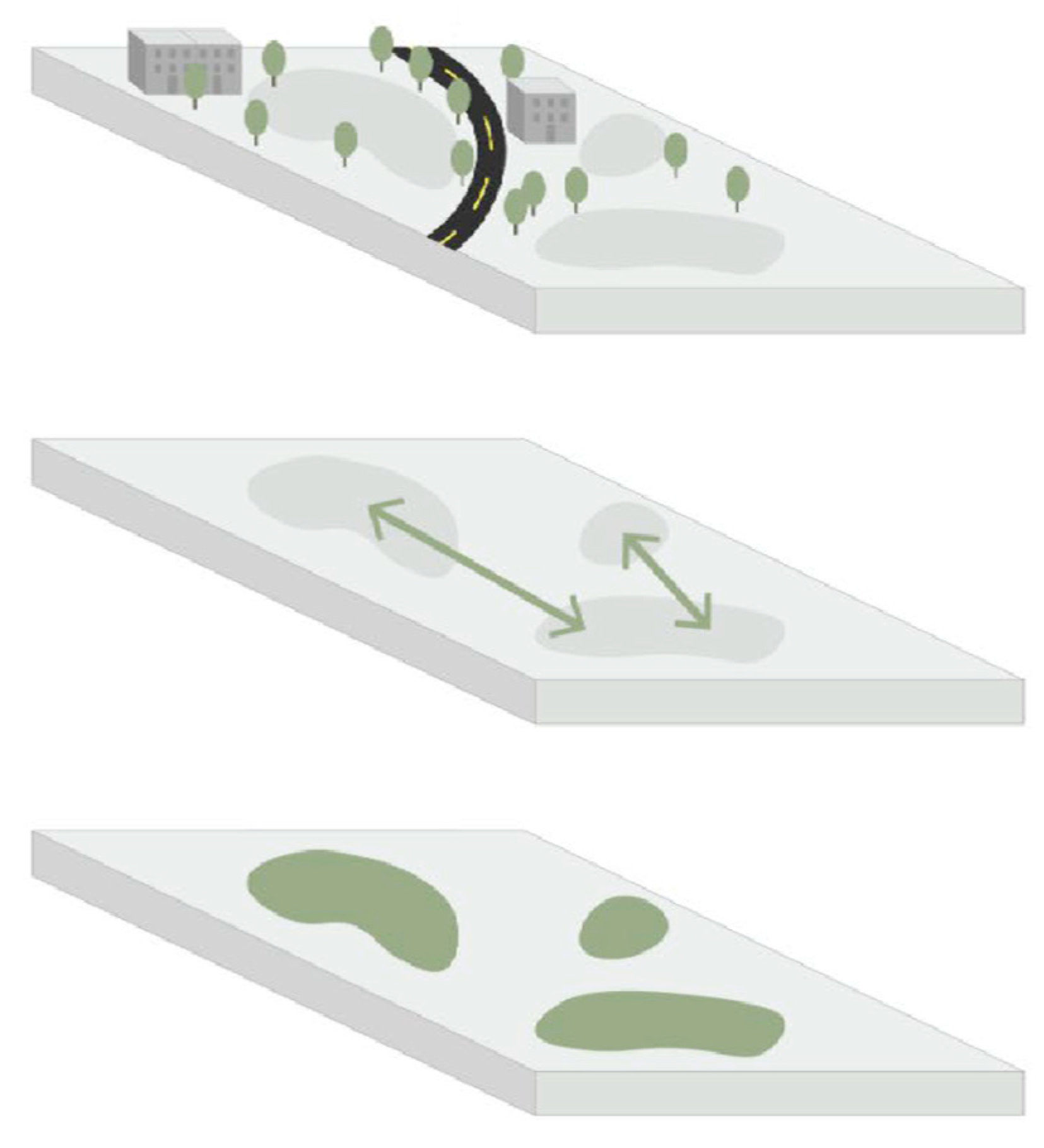


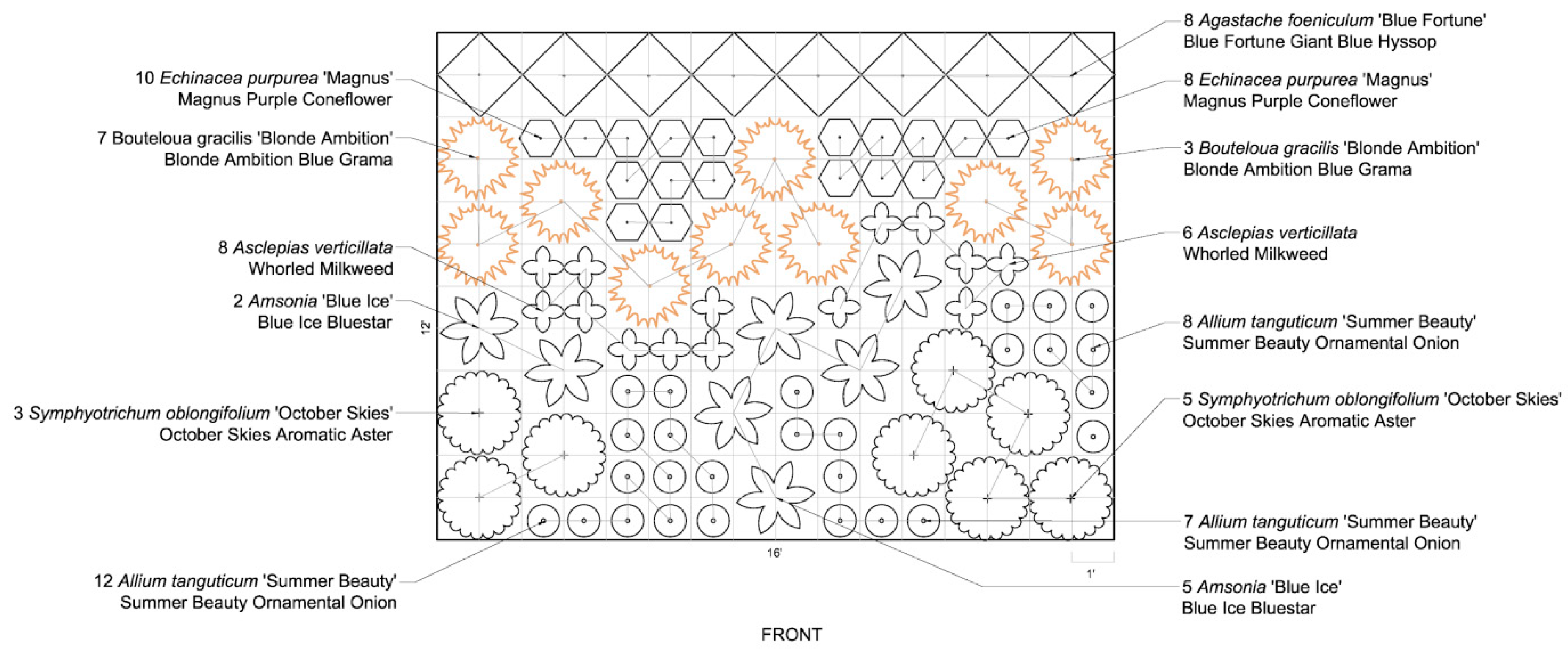
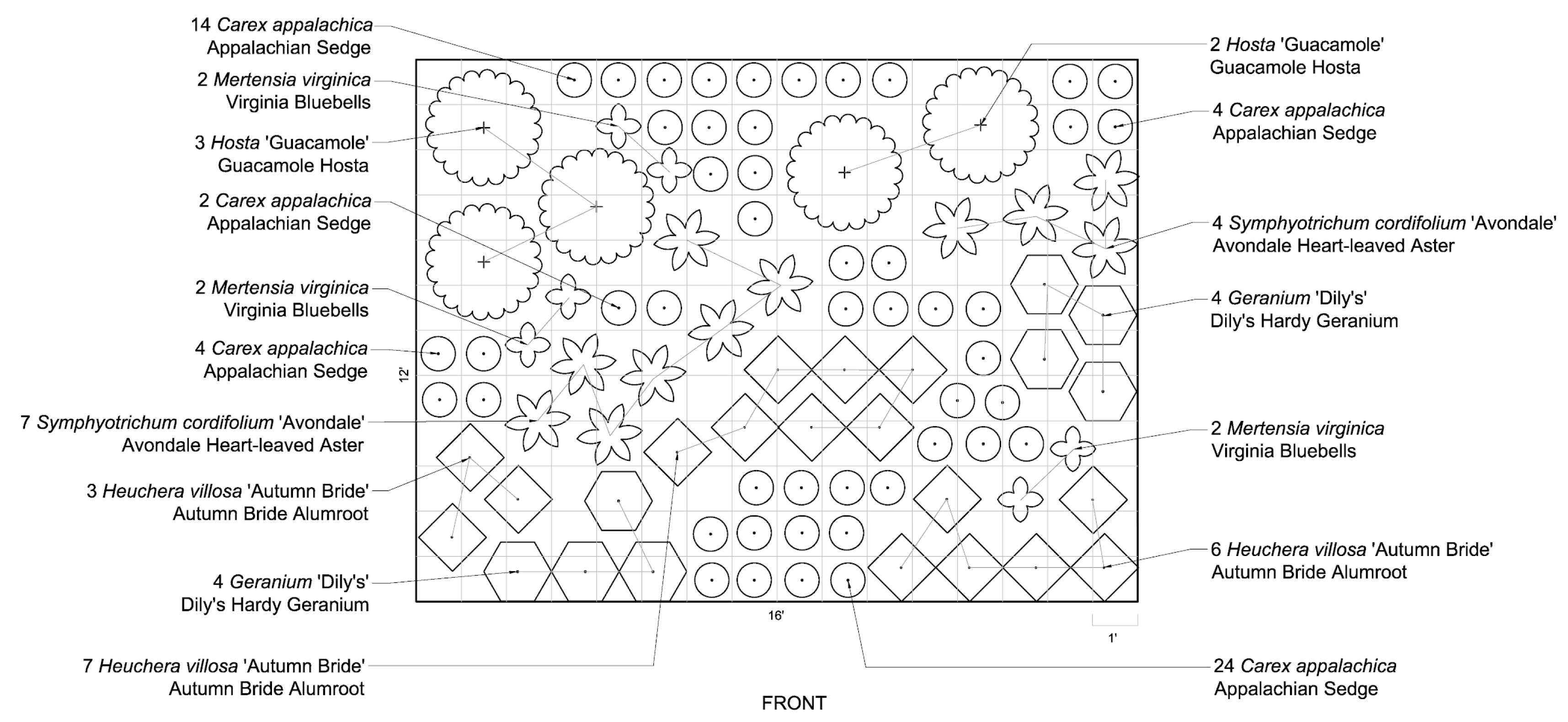
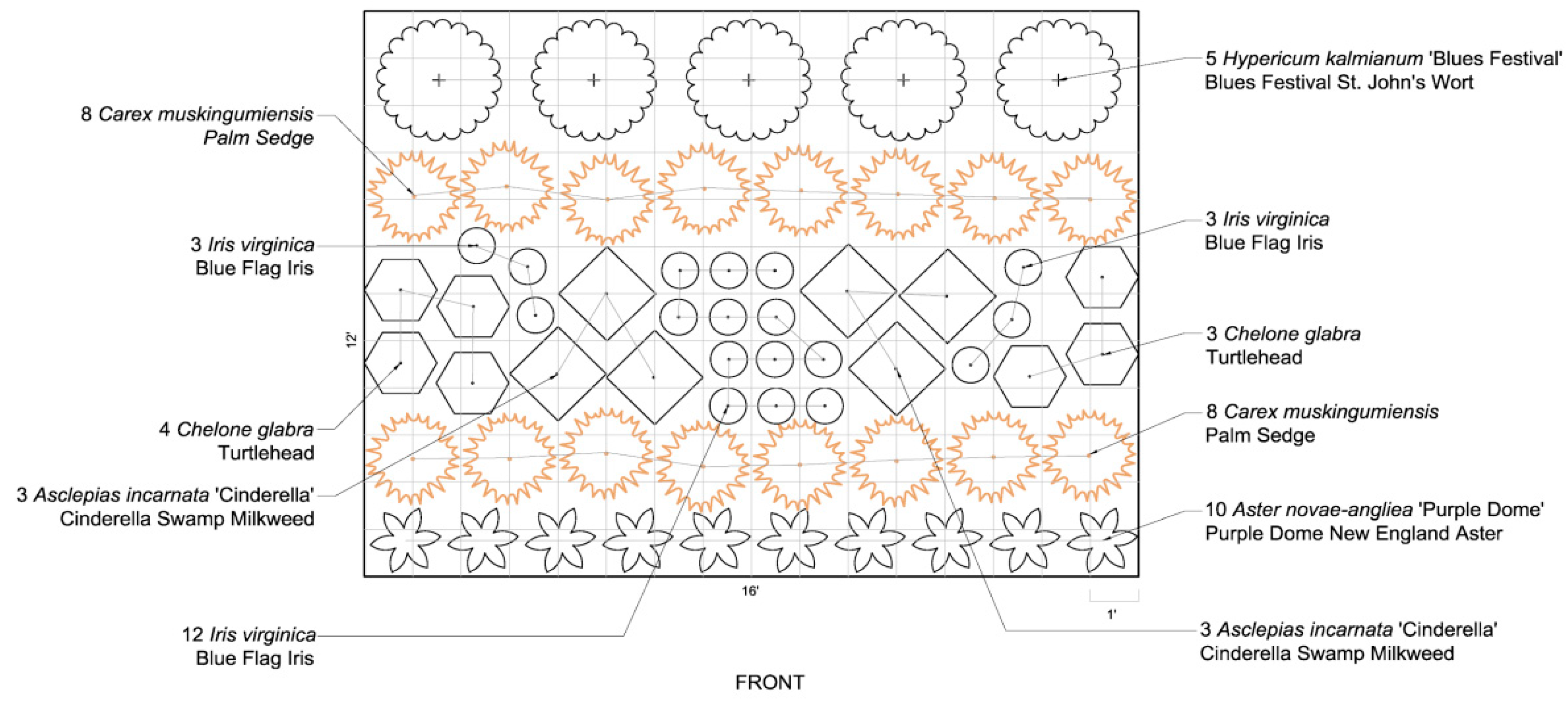
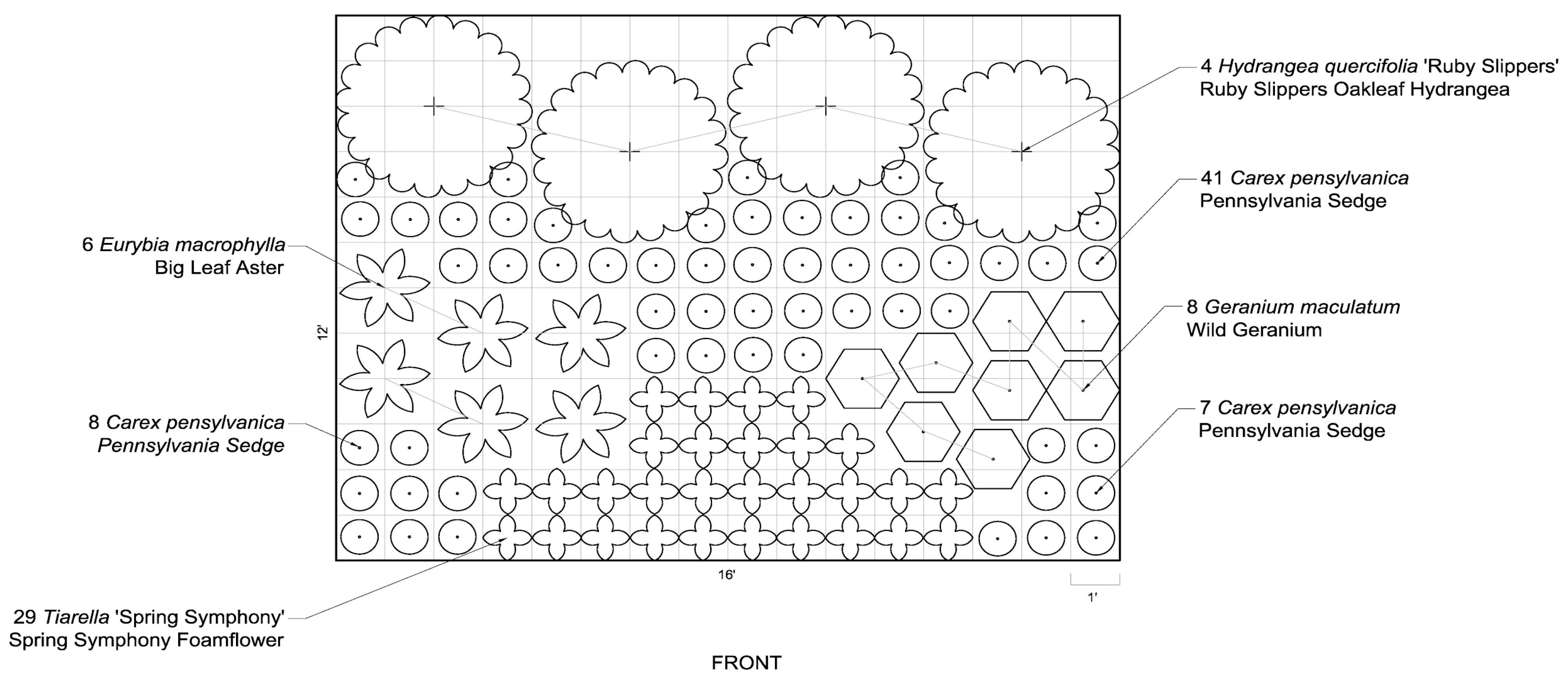

| Category | Species |
|---|---|
| Bees | Many (but not all): bumblebees (Bombus spp.), sweat bees (Halictus sp. and Lasioglossum sp.), leaf-cutter bees (Megachile sp.), carpenter bees (Xylocopa sp.) |
| Wasps | Paper wasps (Polistes sp.), yellowjacket (Vespula), bald-faced hornet (Dolichovespula) |
| Butterflies and moths | Hummingbird moths (Hemaris sp.), sulphurs (Colias sp.), swallowtails (Papilio sp.), fritillaries (Speyeria sp.) |
| Flies | Families: bee flies (Bombyliidae), Syrphid (hover) flies (Syrphidae), Tachinid flies (Tachinidae), thick-headed flies (Conopidae) |
| Beetles | Families: soldier beetles (Cantharidae), long-horned beetles (Cerambycidae), leaf beetles (Chrysomelidae), snout beetles (Curculionidae) |
| Pollinator | Flower Trait Association |
|---|---|
| Bees | Primary color: pink, purple, or blue Secondary: white or yellow. |
| Wasps | Shallow corollas for nectar; white. |
| Butterflies and day-foraging moths | Flat-topped flowers or a structure to grasp while nectaring. Prefer composite flowers. |
| Night-foraging moths | White or cream with a strong fragrance. |
| Flies | Flat or bowl shapes, umbels. White or cream color. Musty fragrance. |
Disclaimer/Publisher’s Note: The statements, opinions and data contained in all publications are solely those of the individual author(s) and contributor(s) and not of MDPI and/or the editor(s). MDPI and/or the editor(s) disclaim responsibility for any injury to people or property resulting from any ideas, methods, instructions or products referred to in the content. |
© 2023 by the authors. Licensee MDPI, Basel, Switzerland. This article is an open access article distributed under the terms and conditions of the Creative Commons Attribution (CC BY) license (https://creativecommons.org/licenses/by/4.0/).
Share and Cite
Schueller, S.K.; Li, Z.; Bliss, Z.; Roake, R.; Weiler, B. How Informed Design Can Make a Difference: Supporting Insect Pollinators in Cities. Land 2023, 12, 1289. https://doi.org/10.3390/land12071289
Schueller SK, Li Z, Bliss Z, Roake R, Weiler B. How Informed Design Can Make a Difference: Supporting Insect Pollinators in Cities. Land. 2023; 12(7):1289. https://doi.org/10.3390/land12071289
Chicago/Turabian StyleSchueller, Sheila K., Zhelin Li, Zoe Bliss, Rachelle Roake, and Beth Weiler. 2023. "How Informed Design Can Make a Difference: Supporting Insect Pollinators in Cities" Land 12, no. 7: 1289. https://doi.org/10.3390/land12071289
APA StyleSchueller, S. K., Li, Z., Bliss, Z., Roake, R., & Weiler, B. (2023). How Informed Design Can Make a Difference: Supporting Insect Pollinators in Cities. Land, 12(7), 1289. https://doi.org/10.3390/land12071289







